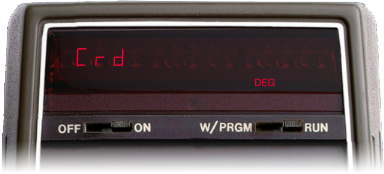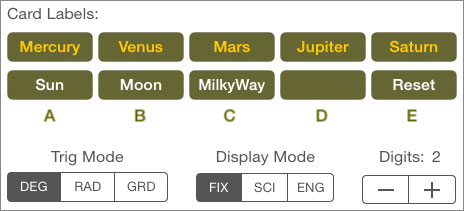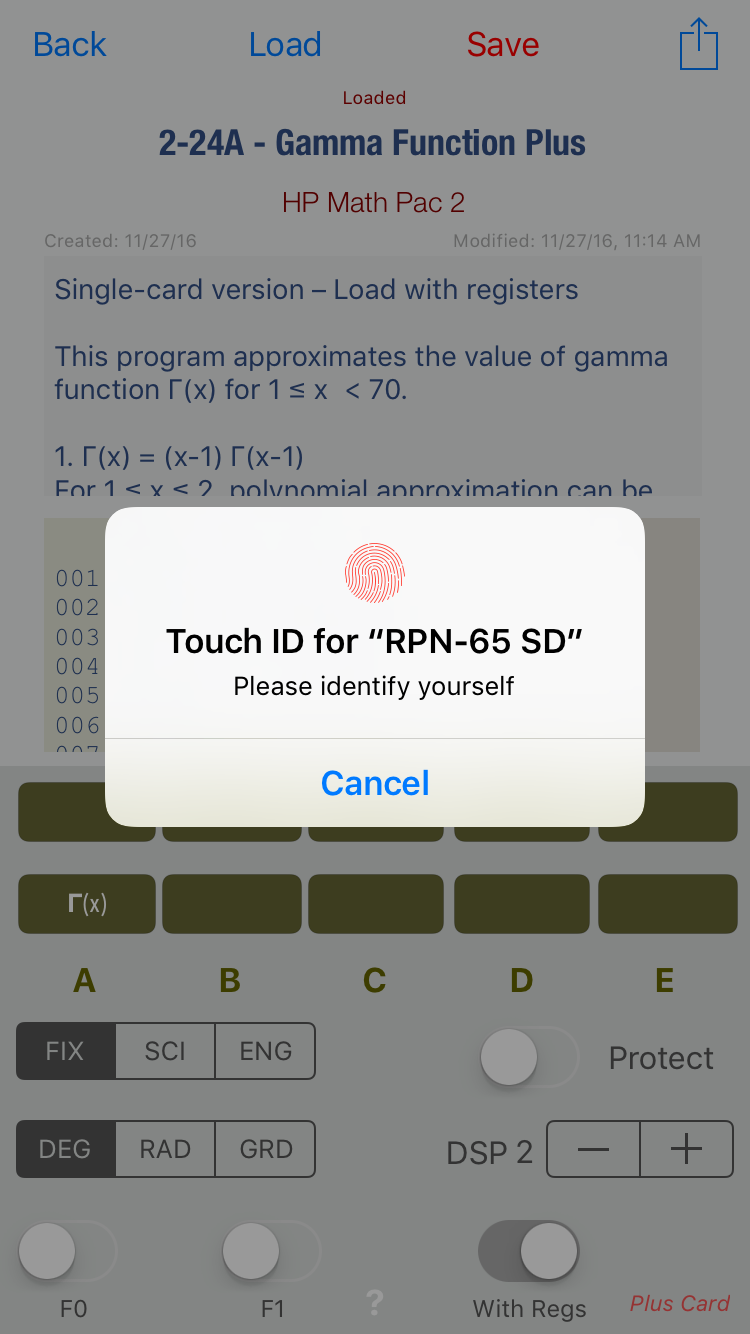Advanced Features — For the Pros
|
Source Code Editing
lbl A // Start
Enter
1x
atan
sto5
gto 1
return
rem Calculate first value
lbl 1
rcl 5
sto 9
xy
yx
stop
down
sqr
gto2
ret
label 2 'Second value
57
fac
*
0.314
+
DSP.2
ret
• In PRGM mode, go to the step where you want to insert the new code, then tap and hold the display and paste.• In RUN mode, open the card manager and paste the code into the listing. • In the program listing (in RUN mode), edit any line by typing in the desired keycode or command name. Make sure to also delete the current keycode, as keycodes take precedence over command mnemonics. Error Checking Unrecognized commands are identified in the listing as shown below: 
Simply tap the red message to scroll the next error into view. Mnemonics Command names recognized by RPN-65 Pro are shown below. Input is case-insensitive, except where it matters, e.g. LBL a vs. LBL A. Mmnemonics in italic are available in Plus mode only. Hints: • Enter commands as shown below, without prefix keys f, f⁻¹ or g • Commands like LBL 3, GTO 5, DSP.2 may be entered on a single line, with or without blanks • A positive multi-digit value may be entered on a single line, e.g. 1.732 A convenient way to create a program is to use the instructions area for entering and editing the source text, including comments. Simply copy the text to the listing area for automatic translation.
|
||||||||||||||||||||||||||||||||||||||||||||||||||||||||||||||||||||||||||||||||||||||||||||||||||||||||||||||||||||||||||||||||||||||||||||||||||||||||||||||||||||||||||||||||||||||||||||||||||||||||||||||||||||||||||
|
*LBL A:
001: 23 LBL
002: 11 A
003: 41 ENT↑
004: 35 g
005: 04 1/x
006: 32 f⁻¹
007: 06 TAN⁻¹
008: 33 05 STO 5
009: 22 GTO [012]
010: 01 1
011: 24 RTN
LBL 1:
012: 23 LBL
013: 01 1
014: 34 05 RCL 5
015: 33 STO
016: 09 9
017: 35 07 g x≷y
018: 35 g
019: 05 yˣ
020: 84 R/S
021: 35 08 g R↓
022: 32 f⁻¹
023: 09 x²
024: 22 GTO [027]
025: 02 2
026: 24 RTN
LBL 2:
027: 23 LBL
028: 02 2
029: 05 5
030: 07 7
031: 35 g
032: 03 n!
033: 71 ×
034: 83 .
035: 03 3
036: 01 1
037: 04 4
038: 61 +
039: 61 DSP
040: 83 .
041: 02 2
042: 24 RTN
(NOTE: STO 9 translates into a merged command in Plus mode)
|
||||||||||||||||||||||||||||||||||||||||||||||||||||||||||||||||||||||||||||||||||||||||||||||||||||||||||||||||||||||||||||||||||||||||||||||||||||||||||||||||||||||||||||||||||||||||||||||||||||||||||||||||||||||||||
Data Cards
|
Unlike the HP-65, RPN-65 Pro can handle data cards. Data cards store register contents which may be retrieved by simply reading the card. This is very useful for presetting registers with constants without wasting many program steps (one per digit of each value.)
Data cards may be loaded in all modes, but only modes UI and Plus can also write data cards. To write a data card:
RPN-65 Pro also imports data cards created by RPN-67 and RPN-97 (see right). g W/DATA is programmable. If the running program encounters this command, it will stop and show the message "Crd". You can then proceed as shown above. After returning from the card manager, the program will continue automatically. You can also dismiss the "Crd" prompt by tapping any key. Then tap R/S to continue program execution. |
||||||||||||||||||||||||
|
|
||||||||||||||||||||||||
Plus Cards
|
Both program and data cards created or duplicated in Plus mode are marked as "Plus Cards" (see pictures at right.) Plus cards support the additional features of RPN-65 Pro in Plus mode, such as:
|
|||
|
|
"Magic 99"
|
In Plus mode, address 99 is used for extra features. Auto-Executing Subroutine 99 If a subroutine identified by LBL 99 exists, it will be executed automatically after the program card has been loaded from the card manager. Applications of this feature include setting up the calculator by storing values in the registers without requiring the user to press any key. Cards containing an auto-executing subroutine are identified like this:
Register 99 Functions If register 99 contains a certain pre-defined value, recalling this value will execute a function instead of returning the value. Special values are defined as ±nE99, where n = 1..9. See the table at right for available functions. Example: 9 EEX 99 STO.99 stores the value for function 9 in register 99. Executing RCL.99 will then produce the sound BEEP 1. Note that you can store 99 in register 8 and then use indirect STi and RCi (g STO and g RCL) to access register 99.
|
||||||||||||||||||||||||||||||||||||||||||||||||||||||||||||||||||||||||
|
Program Cards with Registers
|
Tips: By storing the stack in registers R.00..R04 (using STO ENTER), you can easily restore the stack on loading the program. Just execute RCL ENTER, possibly as an auto-executing subroutine (see "Magic 99" above.) To save program changes, don't turn "With Regs" on, unless you want to update the register data. Registers stored on a card are not affected by resaving the program. |
|
Using Touch ID / Face ID
|
From now on, whenever registers are about to be stored or retrieved from the associated program card, you'll be prompted to identify yourself. If authorization fails, registers will be simply ignored. Fallback to a passcode is not supported.
Note: Activating "With Regs", then double-tapping the Touch ID-protected card in the card list will take you back to the card details. Use "Load" to load card. |
|







